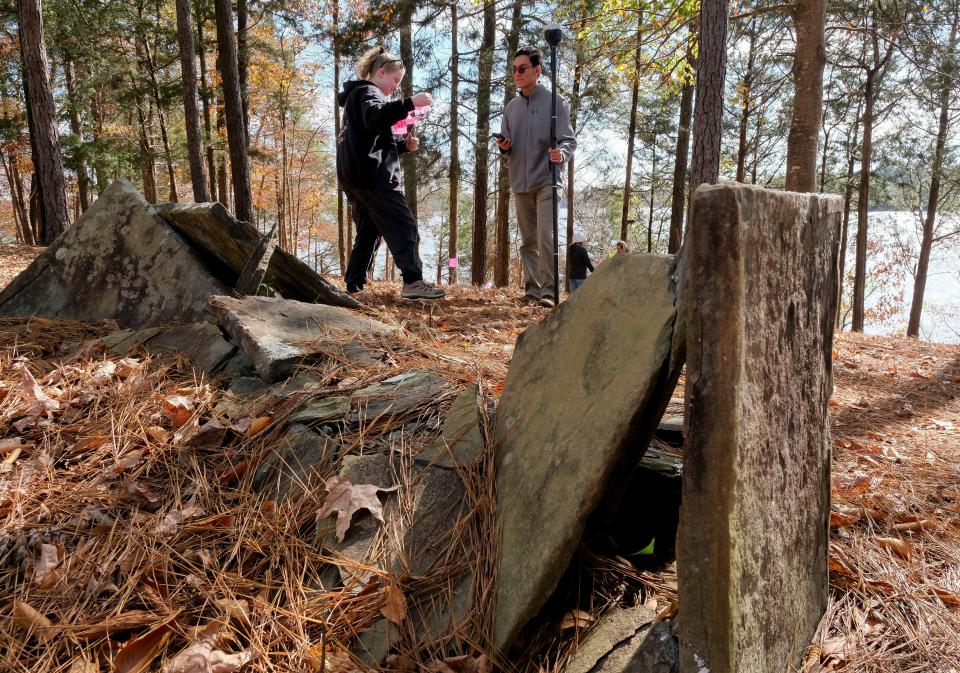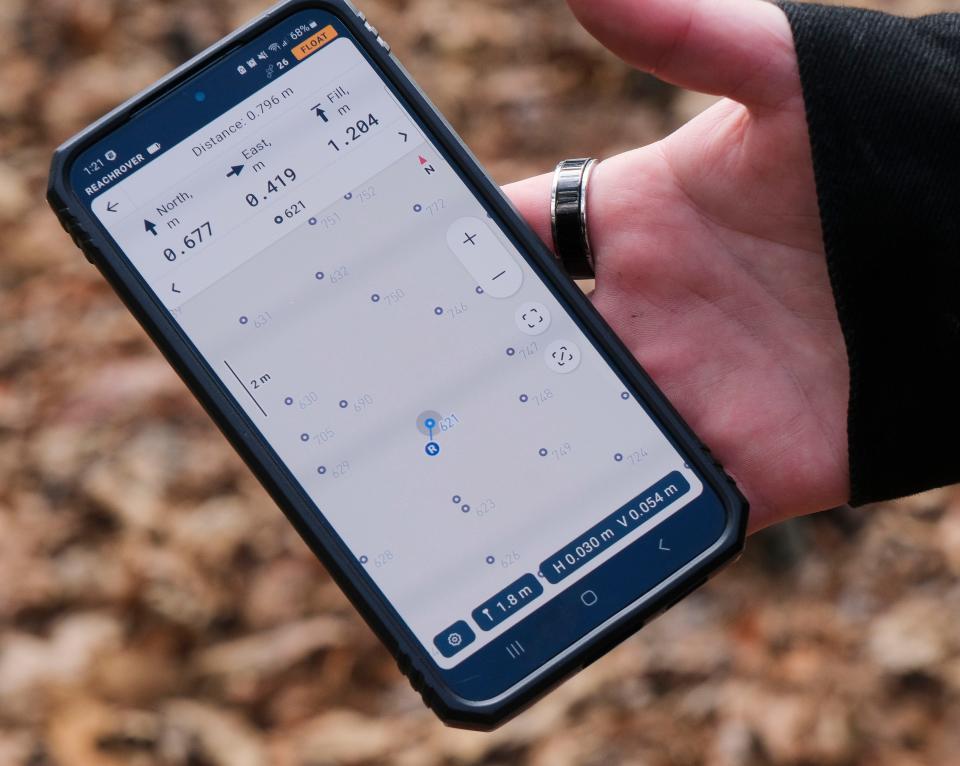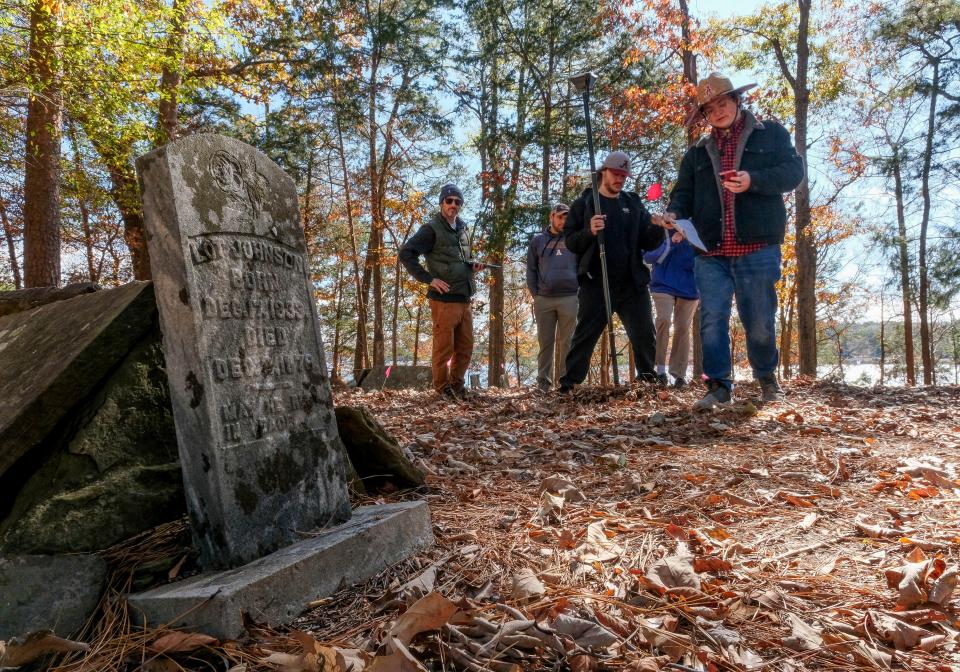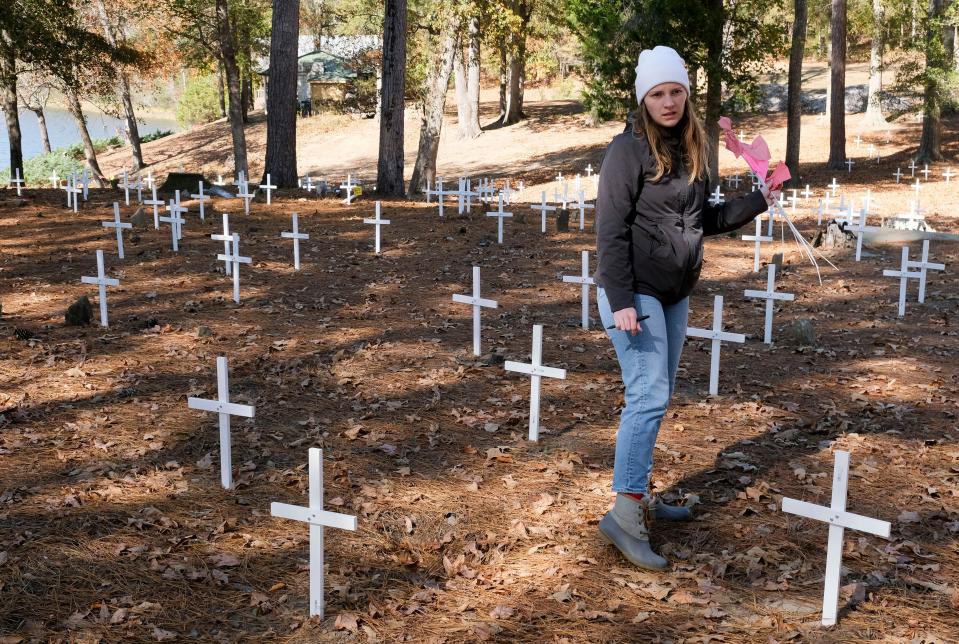University of Alabama anthropology students help mark graves in Prewitt Slave Cemetery
University of Alabama student Jorge Koidi Ikeda-Sanchez walked through the Prewitt Slave Cemetery with his classmate, Molly Elliott, carrying plastic flags and a GPS locator. They were part of a team of students from the University of Alabama anthropology department helping locate and mark graves in the historic cemetery on the Old Byler Road in Tuscaloosa County.
Ikeda-Sanchez, who was born in Cuernavaca, Mexico, grew up in Springhill, Tennessee, and is a sophomore working on a bachelor of arts degree in anthropology, a bachelor of science degree in psychology, and he's on the accelerated masters in business administration path with an aspiration for a career in diplomacy.
More: Alabama's forgotten 'first road' gets new tourism focus
"I think that it is a very formative experience. We are learning how archaeology actually applies," Ikeda-Sanchez said for the grave marking.
"Learning theory is one thing, but actually applying it in a practical sense is another. We are helping a community get a bit of the past back, given how long this cemetery has been derelict and ignored. I feel like it is very meaningful that we are out here marking graves where their ancestors were buried. It is very meaningful. It shows the practical applications of archaeology in a meaningful way," he said.

Last fall, anthropology students identified the location of more than 800 graves in the slave cemetery using high-tech sensing devices that more than doubled the known number of burials in the cemetery on the north shore of Lake Tuscaloosa.
Pat Kemp, president of the Prewitt Slave Cemetery Association, said the collaboration began when she found something that she could not explain while clearing the land. The remnant of an old concrete structure, which Kemp and some experts believe was the foundation of a latrine, brought her to the attention of Elliot Blair, an associate professor at the University of Alabama.
"Last fall, we brought our archaeological field school out here and we did a survey of all the grave markers and we did four different (sensing) methods; ground penetrating radar, electromagnetic induction, magnetic radiometry and electric resistivity," Blair said. "All of these methods are ways of imaging what is beneath the ground without doing anything invasive."
The purpose of the survey was two-fold. For the UA students, it gave them an opportunity to work in the field and use the specialized equipment that had been presented in theory in the classroom. For Kemp, it was an opportunity to get expert help when she had absolutely no money to hire anyone.

"When he (Blair) contacted me, I thought maybe I can get them to help me. He had the same idea, maybe we can use the cemetery for training. When he got here, were agreed we were both looking for the same thing," Kemp said.
"I wanted to offer some type of education for the cemetery to provide to high schools or colleges, whatever. It was a good fit. The school got an opportunity to get in the community. As a community organization, I got an opportunity to help with education."
That fall survey identified about 820 graves. Previous estimates had ranged between 200 and 500 graves, but no one had an accurate count. Magnetic gradiometry was used to detect abnormalities in the soil that are created when the ground is disturbed, which helped define the location of graves. Ground-penetrating radar permitted students to see larger objects such as caskets, burial markers that had been covered over and perhaps some larger bone structures.
"The ground-penetrating radar is reflecting off of something that is buried so it could be just a difference in the soil matrix because of the grave shaft," Blair said. "There could be a casket. It could be actual human remains, the cranium, perhaps, but we don't see individual bones or specific human remains. We are detecting something different in the subsoil from one area to another. Graves in particular show up very differently from the undisturbed soil around them."

Molly Elliott, an anthropology and religious studies major, from Tuscaloosa, said, "This is the first time I've used any equipment like this. I was really afraid of being bad at (working with the sensing equipment) but it's actually a lot easier than I thought it would be."
"I was actually really nervous to come to the cemetery at first. Cemeteries make me feel uneasy because I don't want to be disrespectful or do something wrong. Working with Pat, who is actually a descendant of someone who is buried here, eased my mind because it was kind of like we were not unwelcome and realizing we were trying to help her and her family with what they are trying to do here has been really nice," Elliott said.
Kemp has two ancestors buried in the cemetery. Her great-grandfather, Charlie Hagler who was owned by the Wiley Hagler family, and her great-great-grandmother was Eliza Jane Prewitt Hagler who was owned by Johnny Prewitt, are both buried there. Like many of the graves in the historic cemetery, their graves were not marked with a headstone. Kemp knows they are there, but she cannot pinpoint the exact location.

"This has been a wonderful project for our students in a lot of ways," Blair said.
"One, just using these different technologies, these geophysical methods, that is sort of the cutting edge of archaeological methods today. We still dig, but being able to go out and non-invasively work with the site, that is the cutting edge. At the same time, we are always trying to do community based work so getting to work with Pat and the Prewitt Slave Cemetery Association, that's great for the students, too, to get to do a project that really makes a difference," Blair said.
Gary Cosby Jr. is the photo editor of The Tuscaloosa News. Readers can email him at gary.cosby@tuscaloosanews.com.
This article originally appeared on The Tuscaloosa News: University of Alabama students mark graves in Prewitt Slave Cemetery

